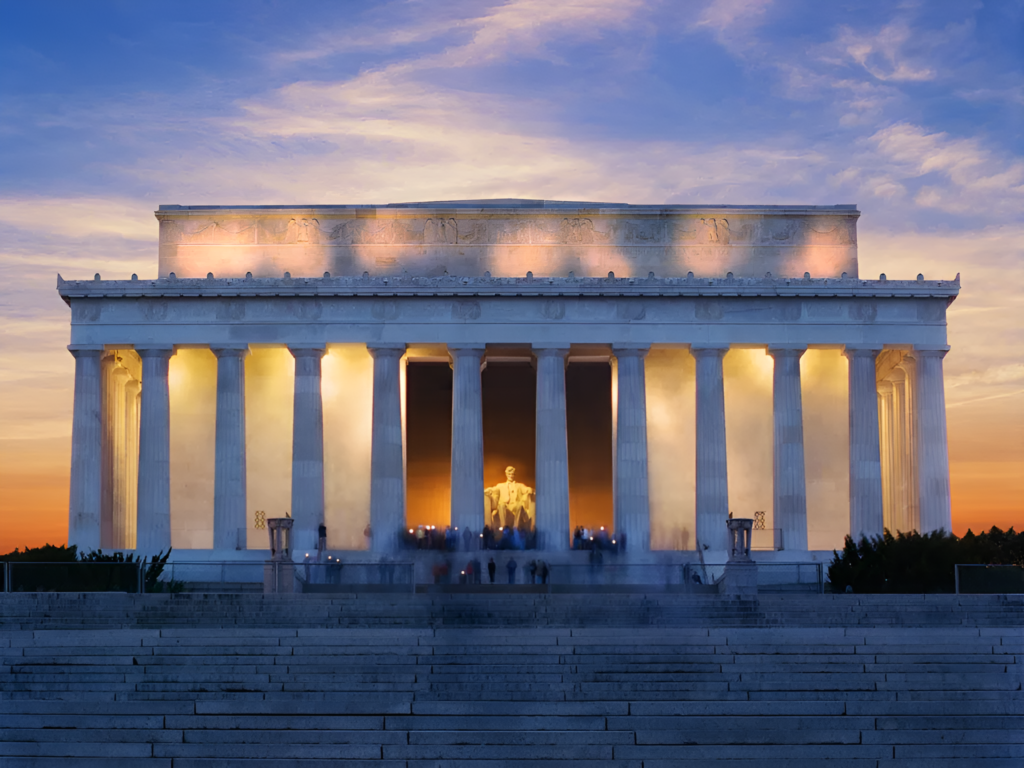It is one of the most iconic memorials in the United States, and it was built in Washington DC, known as Lincoln Memorial. It was introduced in honor of the 16th U.S. President, Abraham Lincoln, for his leadership during the Civil War and his contribution to ending slavery. A symbol of the Union, freedom, and Lincoln’s American values.
Historical Background
The construction of the Lincoln Memorial started in 1914 and was completed in 1922. Henry Bacon, the architect, designed it by choosing a Greek temple to distinguish Lincoln’s physical and mental holdings specifically. In the center of the structure, a colossal statue of Abraham Lincoln, created by the renowned sculptor Daniel Chester French, sits majestically within the memorial.
This version emphasizes the statue as the subject and provides a smoother flow with transitional words. The 19-foot-tall figure shows Lincoln in a contemplative pose and signifies him as a legacy of wisdom and leadership.
Architectural Design
Its design is inspired by ancient Greek temples. The structure features 36 Doric columns to express the number of states in the Union at the time of Lincoln’s demise. On the walls inside are two of his great speeches, the Gettysburg Address and his Second Inaugural Address—and on the outside walls is a distillation of Lincoln’s thoughts. The memorial’s simplicity and majesty reflect Lincoln’s connection to the generations and his commitment to justice and equality.
Symbolism of the Memorial
The importance of the Lincoln Memorial is Its open, inviting frame suggests that the Lincoln legacy belongs to all Americans. The reflecting pool in front of it mirrors its imposing image, and further on is the National Mall often a venue for historic speeches and protests. It has also been a site for civil rights activism. The steps are where Dr. Martin Luther King Jr. gave his iconic “I Have a Dream” speech in 1963, establishing the monument as a symbol of liberty and justice in America.
Visitor Experience
The Lincoln Memorial is always open, so if you are looking for something to do in Washington, D.C., this is a must-see. So that travellers can see it in the daytime and at night under bright lights. Visitors can climb the broad steps to the memorial and gaze up at Lincoln. The atmosphere is usually peaceful, offering a moment of reflection on Lincoln’s legacy.
Indeed, NPS staff members are there to provide information and lead tours from 9:30 a.m. until 10 p.m. every day of the week. The public is welcome to enter, and there is no admission fee charged.
American Cultural Significance
More than just its architectural virtues, the Lincoln Memorial is as iconic in American culture a place as any. It is a place with a long and celebrated past — it has hosted presidential inaugurations and protests large and small. The steps of the memorial have been a stage for those fighting for civil rights and social justice, and his memorial continues to attract visitors from all walks of life.
The memorial, featured in many iconic movies, shows, and photos, became an easily recognizable symbol worldwide. Its peaceful setting belies the sometimes violent eras it remembers, offering a time to reflect on both our past as a country and current struggles for equality.
Events and Activities
Celebrations of Lincoln’s birthday (February 12) and the anniversary of the March on Washington (August 28) would take place throughout the year in front of the Lincoln Memorial. The events traditionally include speeches, a wreath-laying ceremony, musical performances, and public gatherings that honor Lincoln’s memory.
Visitors can also enjoy ranger-led tours, which provide a deeper insight into the memorial’s history and significance. These tours typically discuss the memorial’s architecture and highlight Lincoln’s life, showcasing essential lessons from this significant site in American history.
Accessibility and Neighbourhood
Its position on the western end of the National Mall, combined with its proximity to other parts of Washington, D.C., makes it easily accessible by foot, bicycle, or public transportation. The monument is fully wheelchair accessible, with ramps and elevators to allow every visitor the possibility to enjoy the statue.
It is near the Reflecting Pool, Vietnam Veterans Memorial, and Washington Monument. The Lincoln Memorial and other landmarks surround the National Mall, creating a major center for historical and cultural tourism. Keen visitors spend an entire day touring the area and seeing with their eyes the importance of its beauty.
Maintenance and Preservation
The preservation of the Lincoln Memorial is an ongoing endeavor. The National Park Service maintains it. Frequent alterations in cleaning as well as maintenance of the marble kept aging from getting more significant. Additionally, they handle any problems from the structure that can develop over time.
The memorial is the venue for special events and ceremonies. Such events needed meticulous planning and coordination. The memorial continues to serve as the center of national remembrance.

